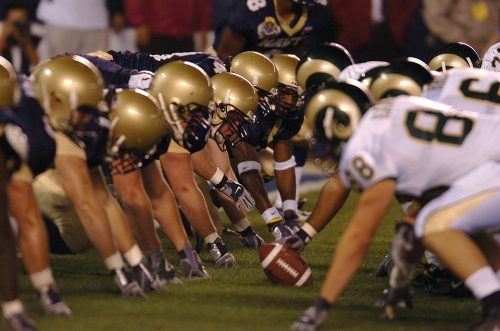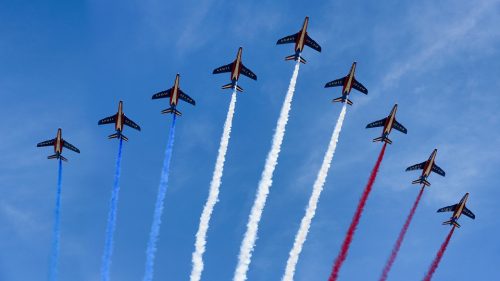Editor’s Note: This article originally appeared in the Toronto Star.
 The NFL’s premier event coincidentally features Patriots battling Eagles, the national symbol, but it has been revealed recently that the armed forces pageantry that is now part of the game was paid for by the U.S. Department of Defense.
The NFL’s premier event coincidentally features Patriots battling Eagles, the national symbol, but it has been revealed recently that the armed forces pageantry that is now part of the game was paid for by the U.S. Department of Defense.
Super Bowl XLII on Sunday between New England and Philadelphia coincidentally features a battle between patriotic brands while the National Football League’s related brand image is increasingly challenged.
New England’s team name – Patriots – obviously refers to someone who loves, supports and defends their homeland. Determined by a public contest, the team’s name was initially the Boston Patriots when they began play in 1959 as part of the nascent American Football League.
New England’s opponent, Philadelphia, is an NFL franchise that dates back to 1933. The team was named the Eagles to respect the blue eagle symbol of the New Deal and the National Recovery Administration. Overseen by former president Franklin D. Roosevelt, a series of federal programs, policies and financial reforms were implemented in response to the Great Depression.
The bald eagle, in particular, has been the official emblem of the United States since 1782 when it was placed with outspread wings on the Great Seal of the United States. Serving to symbolize longevity, freedom, courage and strength, the bald eagle is depicted on American currency, military insignia, official documents of U.S. government institutions and the House of Representatives mace.
The NFL logo, meanwhile, shows stars (and stripes until the late 1960s), as well as red, white and blue.
The NFL has long cultivated a patriotic brand image. Unlike the other major professional sports leagues in North America, all NFL teams are based in U.S. cities. Pre-game ceremonies include traditional flyovers to accompany the singing of the national anthem while military personnel in uniform are commonly paid tribute. Such displays of patriotism are intensified for the Super Bowl game.

Yet the authenticity and strength of the NFL’s patriotic brand image are being challenged as a result of its pre-game rites.
We have learned that the pre-game military displays of patriotism at NFL games were commonly paid for by the U.S. Department of Defense, and in effect at the expense of U.S. taxpayers. John McCain and Jeff Flake, Republican senators from Arizona, produced a report in 2015 revealing how widespread Department of Defense spending was for patriotic displays and troop tributes.
Coinciding with the military payments was the adoption of an NFL policy encouraging players to be on the field and standing for the national anthem.
In 2016, San Francisco 49ers quarterback Colin Kaepernick ignited a movement by not standing for the pre-game national anthem, drawing attention to prevailing racial injustice in the country. Kaepernick, who after that season became a free agent, has since gone unsigned despite good performance credentials.
Kaepernick has launched a grievance case against the NFL, which will include several NFL owners being deposed and is likely to further embarrass the NFL.
As Kaepernick’s movement gained momentum and additional NFL players engaged in demonstrative acts during the national anthem – such as kneeling, raising their fist or interlinking arms with their teammates – President Donald Trump weighed in on the issue.
In September, early in this NFL season, President Trump tweeted: “If a player wants the privilege of making millions of dollars in the NFL, or other leagues, he or she should not be allowed to disrespect our Great American Flag (or Country) and should stand for the National Anthem. If not, YOU’RE FIRED. Find something else to do!”
 Additionally, he stated, “Courageous Patriots have fought and died for our great American Flag – we MUST honor and respect it! MAKE AMERICA GREAT AGAIN.”
Additionally, he stated, “Courageous Patriots have fought and died for our great American Flag – we MUST honor and respect it! MAKE AMERICA GREAT AGAIN.”
President Trump’s statements, while tone-deaf to the underlying issues surrounding racial injustice in the United States, were imperious and made as a self-branding exercise by emphasizing his catchphrases “You’re fired” and “Make America great again.”
There are also questions if the act of kneeling – as done by Kaepernick – is a symbol of disrespect, as well as why the narrative has been largely limited to the interconnections of the national anthem, flag and military. Surely institutions of government, separate from the military, can be challenged by the kneeling movement initiated by Kaepernick.
And the irony is that the U.S. government was paying the NFL millions of dollars for players to be seen as respectful.
This Sunday’s coincidental clash of patriotic team brands is a repeat of Super Bowl XXXIX, but the perceived outlook has changed considerably in the 13 years since their previous matchup.
Timothy Dewhirst is a professor in the Department of Marketing and Consumer Studies, College of Business and Economics, at the University of Guelph.